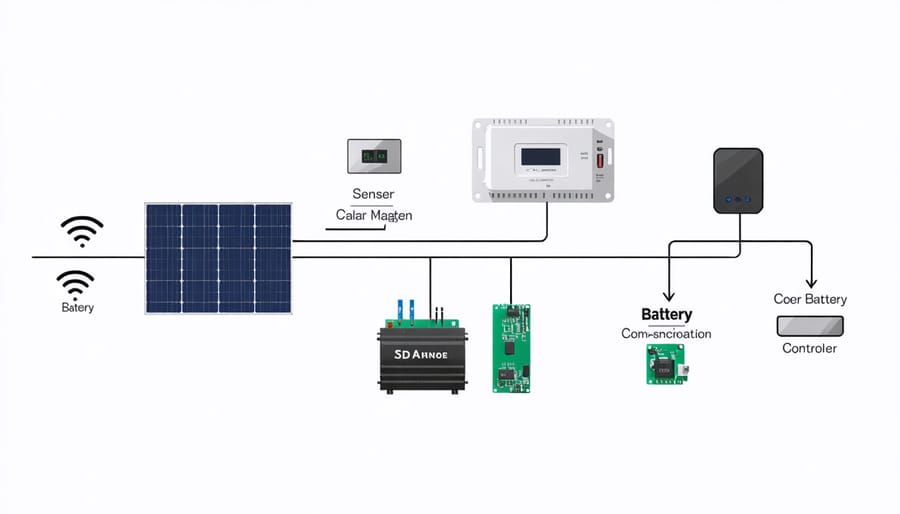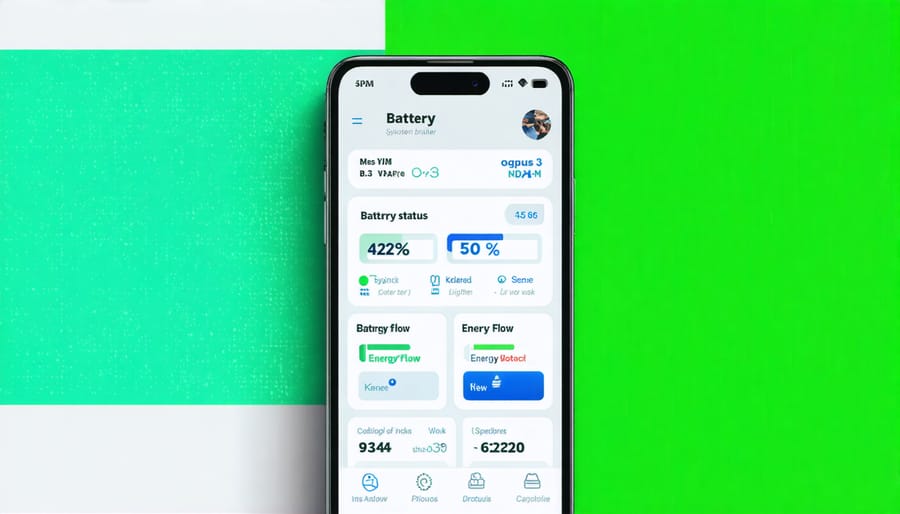Solar Battery Management Systems: Maximizing Your Energy Storage Investment

In the race towards sustainable energy independence, solar battery management systems represent the crucial intelligence behind efficient energy storage and distribution. These sophisticated systems optimize the performance of solar installations by orchestrating the intricate dance between power generation, storage, and consumption. Modern battery management systems not only extend battery life and enhance safety but also maximize return on investment through intelligent load balancing and predictive maintenance capabilities.
As Europe accelerates its transition to renewable energy, these systems have become indispensable for both residential and commercial installations, enabling users to achieve up to 30% greater efficiency in their solar energy utilization. Through advanced monitoring and real-time optimization, battery management systems ensure optimal charging cycles, prevent deep discharge scenarios, and maintain ideal operating temperatures – critical factors that can double the lifespan of solar battery installations.
For homeowners and businesses investing in solar energy solutions, a robust battery management system serves as the cornerstone of energy independence, providing the intelligence needed to navigate varying weather conditions, peak demand periods, and grid interactions while maintaining system health and performance. This technology transforms solar installations from simple power generators into sophisticated energy management hubs, capable of adapting to changing energy needs while maximizing sustainability and cost efficiency.
What Makes Solar Battery Management Systems Essential
Protection and Safety Features
Modern battery protection systems incorporate multiple layers of safety features to safeguard both the energy storage system and its users. These protective measures include overcharge prevention, which automatically stops charging when batteries reach their optimal capacity, and deep discharge protection that prevents batteries from depleting below critical levels.
Temperature monitoring and control systems continuously track battery conditions, activating cooling mechanisms when necessary and shutting down the system if temperatures exceed safe thresholds. Short-circuit protection and current limiting features prevent potentially dangerous electrical surges, while cell balancing ensures even charge distribution across all battery cells for optimal performance and longevity.
Advanced systems also feature integrated fault detection algorithms that can identify potential issues before they become serious problems. Emergency shutdown protocols activate automatically in response to any detected anomalies, while sophisticated monitoring systems provide real-time alerts to system owners and maintenance teams.
These safety mechanisms comply with strict European safety standards and regulations, ensuring reliable operation while protecting your investment and the environment.
Performance Optimization
A well-designed battery management system plays a crucial role in maximizing the performance and lifespan of solar energy storage solutions. Through sophisticated monitoring and control algorithms, the BMS continuously optimizes charging and discharging cycles while maintaining ideal operating conditions. This intelligent management ensures batteries operate within their optimal temperature range and voltage levels, significantly reducing degradation and extending battery life by up to 50%.
The system employs advanced load balancing techniques to distribute energy evenly across battery cells, preventing overcharging and deep discharging that could damage the storage units. Real-time performance monitoring allows the BMS to adjust charging parameters based on environmental conditions, battery age, and usage patterns, ensuring peak efficiency throughout the system’s lifecycle.
Additionally, modern BMS solutions incorporate predictive maintenance capabilities, analyzing performance data to forecast potential issues before they impact system efficiency. This proactive approach, combined with sophisticated power management algorithms, helps achieve optimal charging efficiency rates of up to 95%, maximizing the return on investment for solar energy storage systems while supporting sustainable energy practices across Europe.

Key Components of Modern Battery Management Systems
Monitoring Systems
Modern solar battery management systems incorporate sophisticated battery monitoring capabilities that continuously track crucial parameters to ensure optimal performance and longevity. Temperature monitoring sensors are strategically placed throughout the battery system to detect any unusual thermal patterns that could indicate potential issues or inefficiencies. These sensors help prevent overheating and maintain ideal operating conditions, particularly important in varying European climates.
Voltage monitoring is equally essential, with precision sensors measuring both individual cell voltages and overall battery voltage levels. This granular monitoring ensures balanced charging and discharging cycles while preventing potentially damaging over-voltage situations. The system maintains optimal voltage ranges for maximum efficiency and battery life.
Current monitoring provides real-time insights into charging and discharging rates, essential for protecting the battery from excessive current draw or charging speeds. Advanced systems integrate these monitoring functions with smart algorithms that automatically adjust charging parameters based on collected data.
The monitoring system typically includes a user-friendly interface displaying real-time data and historical trends, enabling property owners to track system performance and receive immediate alerts if parameters deviate from optimal ranges. This proactive approach to monitoring helps prevent system failures and extends battery life while maximizing energy efficiency.
Control Systems
The control systems in a solar battery management system serve as the intelligent backbone that optimises energy flow and storage efficiency. At its core, charge control mechanisms protect batteries from overcharging and deep discharging, significantly extending their operational lifespan. Modern systems employ sophisticated algorithms that monitor charging rates and adjust them based on battery temperature, state of charge, and overall system conditions.
Load management features ensure optimal distribution of stored energy, prioritising critical loads during peak demand or limited solar generation. These systems can automatically switch between different power sources, directing excess solar energy to storage and managing grid interaction when necessary. Smart load shedding capabilities prevent system overload by selectively disconnecting non-essential equipment during high-demand periods.
System optimization goes beyond basic control functions, incorporating predictive analytics and real-time monitoring. Advanced controllers can learn usage patterns and weather forecasts to optimize charging cycles and energy distribution. Many European installations now feature remote monitoring capabilities, allowing users to track system performance and adjust settings via smartphone applications.
For maximum efficiency, these control systems integrate seamlessly with home energy management systems, enabling automated decisions about when to store, use, or sell excess energy back to the grid. This level of intelligent control ensures households and businesses achieve optimal return on their solar investment while maintaining system reliability and longevity.
Smart Integration Features
Remote Monitoring
Modern solar battery management systems offer sophisticated remote monitoring capabilities through dedicated mobile applications and web platforms. These user-friendly interfaces provide real-time insights into your system’s performance, energy production, and battery status directly on your smartphone or computer.
Through these remote management tools, system owners can track key metrics such as battery charge levels, power flow, and energy consumption patterns. The applications typically feature intuitive dashboards displaying daily, weekly, and monthly performance data, helping users optimise their energy usage and storage strategies.
Many European manufacturers have developed smart monitoring solutions that enable automated alerts for system anomalies, predictive maintenance notifications, and remote troubleshooting capabilities. This proactive approach helps prevent potential issues before they impact system performance.
The remote functionality also allows users to adjust system settings, such as charging priorities and power distribution, without physical intervention. For businesses and homeowners alike, this level of control and visibility ensures optimal system efficiency while providing peace of mind through continuous monitoring.
System installers and maintenance teams can also access this data remotely, enabling faster response times and more efficient service delivery when needed.

Data Analytics
Data analytics plays a crucial role in modern solar battery management systems, enabling users to track, analyze, and optimize their energy storage performance. Advanced monitoring platforms collect real-time data on battery charge levels, energy consumption patterns, and system efficiency metrics, presenting this information through user-friendly dashboards.
These analytics tools help identify peak usage periods, track solar generation versus consumption, and calculate cost savings. Through machine learning algorithms, the system can predict energy needs based on historical data and weather forecasts, automatically adjusting charging and discharging cycles for optimal performance.
For European households and businesses, this data-driven approach proves particularly valuable during seasonal variations in solar production. Users can monitor their system’s performance across different weather conditions and seasons, making informed decisions about energy usage and storage strategies.
The analytics platform also provides preventive maintenance alerts, battery health status, and performance optimization recommendations. This proactive approach helps extend battery life and maintains system efficiency, ensuring maximum return on investment while contributing to sustainable energy management.
Installation and Maintenance Considerations

Professional Installation Requirements
The installation of solar battery management systems requires professional expertise and adherence to strict safety standards. While home solar battery systems have become increasingly user-friendly, their integration demands certified electricians who understand both DC and AC power systems.
Professional installers must hold relevant certifications according to European standards, including IEC 62109 for power conversion equipment and EN 50549 for grid connection requirements. These certifications ensure installers can properly handle high-voltage systems and implement safety protocols effectively.
Key installation requirements include:
– Proper system sizing and compatibility assessment
– Correct mounting and ventilation configurations
– Integration with existing electrical infrastructure
– Implementation of safety disconnects and surge protection
– Configuration of monitoring and control systems
– Compliance with local building codes and regulations
Installation professionals must also coordinate with local utilities for grid connection approval and ensure all documentation meets regional requirements. Regular system updates and maintenance protocols should be established during installation to guarantee optimal performance and longevity.
The complexity of these systems means DIY installation is not recommended and could void warranties or insurance coverage. Working with certified professionals ensures your investment is protected and operates at maximum efficiency while maintaining safety standards.
Maintenance Best Practices
Regular maintenance of your solar battery management system is crucial for optimal performance and longevity. Schedule quarterly inspections of all system components, paying special attention to connection points and terminals for signs of corrosion or loose fittings. Clean the system housing regularly to prevent dust accumulation, which can affect cooling efficiency and overall performance.
Monitor your battery management system’s digital interface weekly to track performance metrics and identify any unusual patterns. Key indicators include charge/discharge rates, temperature readings, and voltage levels across battery cells. Document these readings to establish baseline performance and detect potential issues early.
For troubleshooting, start with these common checks:
– Verify all cable connections are secure and free from damage
– Ensure ventilation areas remain unobstructed
– Check for error codes on the system display
– Confirm firmware is up to date
– Inspect for any physical damage or water ingress
If you notice significant performance degradation or recurring error messages, contact a qualified technician immediately. Many modern systems feature remote diagnostic capabilities, enabling swift identification of issues before they escalate into major problems.
Keep detailed maintenance records, including dates of inspections, any repairs performed, and system performance data. This documentation is invaluable for warranty purposes and helps optimise system performance over time.
Remember to review safety protocols annually and ensure emergency shutdown procedures are clearly displayed near the installation.
As solar energy continues to shape Europe’s sustainable future, battery management systems remain a cornerstone of efficient and reliable energy storage solutions. The integration of advanced BMS technology has revolutionized how we harness and utilize solar power, offering unprecedented control, safety, and optimization of battery performance.
The importance of BMS extends beyond mere battery protection; it represents a crucial link in the chain of renewable energy adoption. By ensuring optimal battery life, enhanced safety protocols, and maximum energy efficiency, these systems deliver substantial returns on investment for both homeowners and businesses across Europe.
Looking ahead, the future of battery management systems appears increasingly promising. Emerging trends point toward AI-driven optimization, enhanced remote monitoring capabilities, and even more sophisticated predictive maintenance features. These developments will further improve system reliability while reducing operational costs and environmental impact.
As European nations push toward their renewable energy targets, the role of advanced battery management systems will become even more critical. Integration with smart grid technologies and the continued evolution of energy storage solutions will drive innovation in BMS functionality, making solar energy systems more accessible, efficient, and sustainable for future generations.
For those considering solar energy solutions, investing in a quality battery management system is not just a technical necessity—it’s a strategic decision that ensures long-term energy independence and sustainability.
Leave a Reply